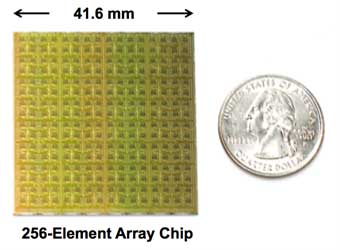TowerJazz, the global specialty foundry leader, and The University of California, San Diego (UCSD), a recognized leader for microwave, millimeter-wave and mixed-signal RFICs, today announced they have collaborated to demonstrate the first 256-element (16 x 16) wafer-scale phased array transmitter with integrated high-efficiency antennas operating at 56-65 GHz frequency range.

First time success was achieved for the wafer-scale RFIC using TowerJazz's own proprietary models, kit and the mmWave capabilities of its 0.18-micron SiGe BiCMOS process, SBC18H3.
In addition, TowerJazz proprietary methods allowed for very large chip area with an extremely high level of integration. The phased-array system-on-a-chip (SoC) targets the emerging 5G high-performance wireless standard which will aim for greater than 10 Gbps (gigabits per second) peak data-rate communication. The array has beamforming capabilities that include independent amplitude and phase control for all 256 different antenna elements. By developing this wafer-scale chip, UCSD and TowerJazz have successfully demonstrated highly scalable RF-IC transmitters for 5G phased array applications. The collaboration of the wafer-scale phased array chip was partially funded through collaboration with DARPA.
Phased arrays allow the electronic steering of an antenna beam in any direction and with high antenna gain by controlling the phase at each antenna element. The radiation beam can be "moved in space" using entirely electronic means through control of the phase and amplitude at each antenna element used to generate the beam. This beam steering technique is much more compact and much faster than mechanically steered arrays. Furthermore, phased arrays allow the creation of deep nulls in the radiation pattern to mitigate strong interference signals from several different directions. They have been in use since the 1950s in defense applications and have seen limited use in commercial systems due to their relatively high cost. UCSD's design and utilization of TowerJazz wafer processes are targeted to greatly reduce the cost of phased arrays especially at millimeter-wave frequencies for 5G communication systems.
"This is yet another leap forward in the area of phased arrays that we are proud to announce. We have a track record of successful collaboration with TowerJazz and the ability to bring this innovative design from UCSD to market depends strongly on TowerJazz's SiGe BiCMOS foundry process which enables lower-cost phased arrays through integration of multiple circuit functions and high efficiency antennas on the same silicon chip," said Dr. Gabriel M. Rebeiz, Distinguished Professor of Electrical Engineering at UCSD, the lead professor on this chip.
"We believe the results achieved by UCSD's 5G 60 GHz phased array transmitter again demonstrate the remarkable teamwork between TowerJazz, UCSD and DARPA, to provide novel capabilities and technologies to both the aerospace and defense community as well as commercial markets," said Dr. David Howard, TowerJazz's Executive Director and Fellow & Co-PI for the DAHI Program. "It is satisfying to have our long term collaboration and vision bear fruit, as shown in this demonstration, and to bring attention to our enabling role in emerging 5G markets and standards."